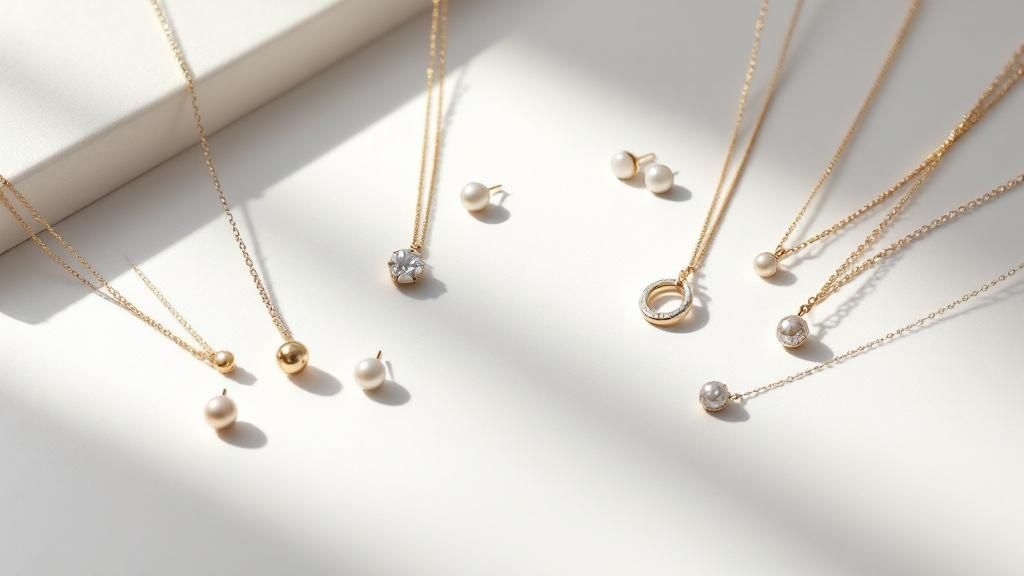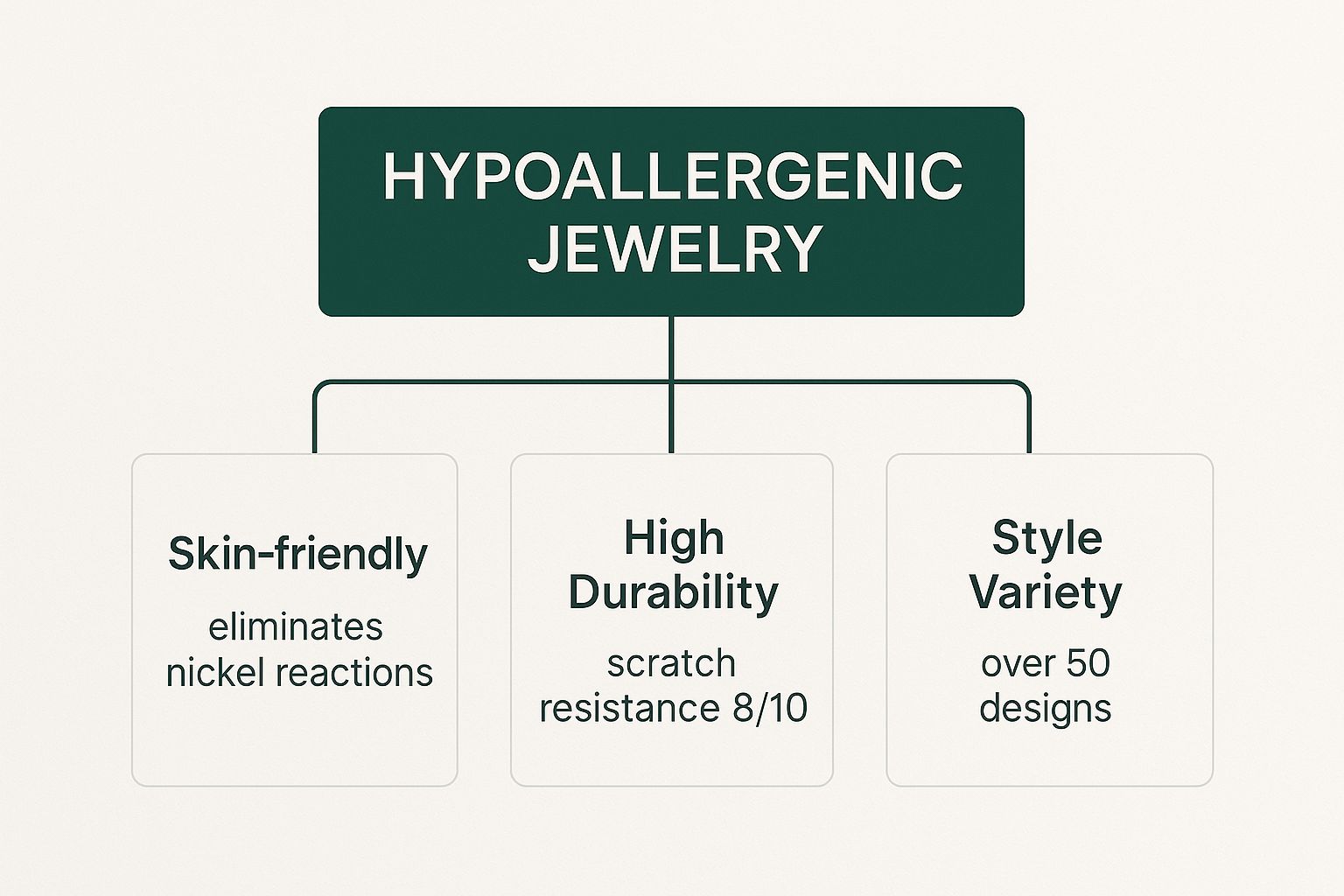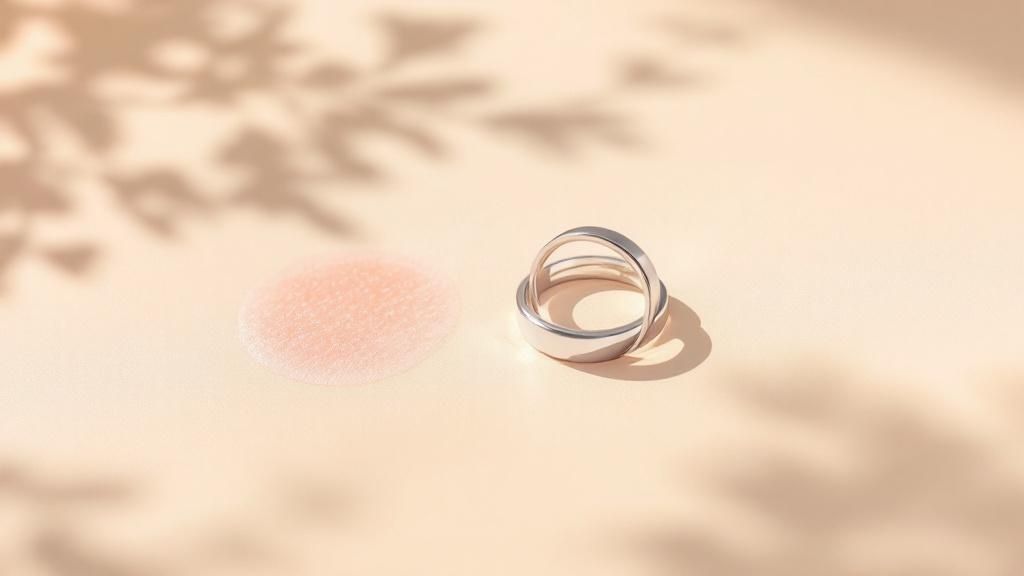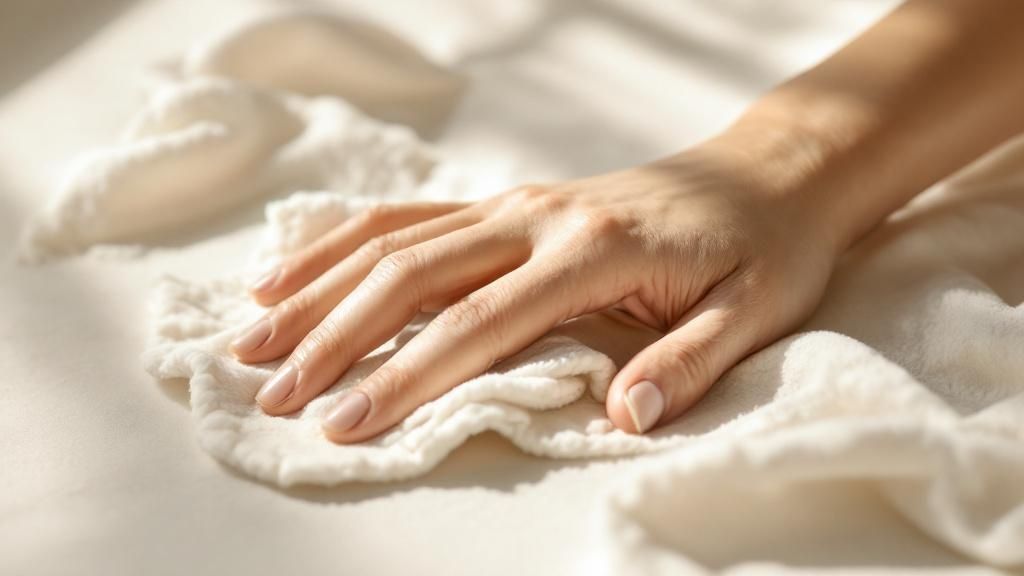- Continue Shopping
- Your Cart is Empty
Hypoallergenic Jewelry: Safe & Stylish for Sensitive Skin
If you’ve ever bought a beautiful piece of jewelry only to end up with red, itchy, or even blistering skin, you know the frustration of a metal allergy. This is where the term hypoallergenic jewelry comes in, but what does it really mean?
Simply put, hypoallergenic jewelry is made from metals that are less likely to cause an allergic reaction. It's not a 100% guarantee against irritation, but it's a huge step in the right direction for anyone with sensitive skin.
What Does Hypoallergenic Jewelry Actually Mean?

That red, swollen, and itchy reaction from a new pair of earrings has a medical name: contact dermatitis. Your skin is literally coming into contact with a material it doesn't like, and it’s letting you know. When you see the word "hypoallergenic" on a jewelry label, it’s a signal that the maker has intentionally avoided the most common culprits.
Think of it this way: "hypoallergenic" is to jewelry what "gluten-free" is to food. A gluten-free label tells you that a known problematic ingredient—gluten—has been left out. It doesn't mean the food is free of all potential allergens, but it eliminates the most common one for a specific sensitivity. In the jewelry world, that primary culprit is almost always nickel.
The Big Problem With Nickel
Nickel is a natural metal, but it’s a notorious troublemaker. It's often mixed into metal alloys to add strength and reduce the cost of jewelry. The problem? For a huge number of people, it's also the #1 trigger for skin allergies.
When your skin touches nickel, your immune system can overreact, mistaking the metal for a harmful substance. This defensive response is what causes the classic signs of an allergic reaction.
What does a nickel allergy look like? It's the dreaded redness, itching, swelling, and sometimes even small blisters or dry, peeling skin right where the jewelry touched you. It’s enough to make you want to give up on accessories altogether.
This isn’t just a niche problem. Metal sensitivities are on the rise globally. Studies estimate that up to 17% of women and 3% of men are allergic to nickel, with millions more sensitive to other metals like cobalt and chromium. The demand for truly skin-safe jewelry has never been higher, and you can explore more jewelry industry statistics to see how big this trend has become.
To make navigating this easier, here’s a quick breakdown of common allergens and their safer counterparts.
Quick Guide to Common Jewelry Allergens and Safe Alternatives
This table highlights the most frequent metal offenders and points you toward the best skin-friendly options to look for instead.
| Common Allergen | Potential Skin Reaction | Safe Hypoallergenic Alternative |
|---|---|---|
| Nickel | Redness, severe itching, blisters, rash | 925 Sterling Silver, Gold, Platinum, Titanium |
| Lead & Cadmium | Can cause rashes and are toxic | Medical-Grade Stainless Steel, Niobium |
| Brass & Copper | Can cause a green stain, mild rash | Gold-Filled, Gold Vermeil, Argentium Silver |
| Cobalt & Chromium | Itching, redness, persistent rash | Platinum, Titanium, Palladium |
Knowing which metals to avoid is the first step. The next is actively seeking out pieces made from high-quality, body-safe materials.
Why This Knowledge Is Your Best Friend
Understanding what "hypoallergenic" truly means is your key to building a jewelry collection you can actually wear—confidently and comfortably. It’s not just about dodging a rash. It’s about making smart, informed choices that put your health first.
When you know the goal is to minimize contact with troublemakers like nickel, you can read product descriptions with a critical eye. This knowledge empowers you to ask the right questions and invest in pieces that are as kind to your skin as they are beautiful.
The Best Jewelry Metals for Sensitive Skin
If you have sensitive skin, finding jewelry that doesn't cause a red, itchy rash can feel like an impossible task. But it doesn't have to be a frustrating game of trial and error. The real key isn't just knowing which metals are "good" or "bad"—it's understanding why they work for sensitive skin. Once you get that, you can confidently choose pieces that you'll love to wear, irritation-free.
Let's break down the most trusted metals out there. We’ll look at what makes each one unique, from its purity and durability to its look and price, so you have all the information you need.
Sterling Silver: A Classic Choice
When you see a piece stamped with "925 Sterling Silver," that’s a sign of quality. It means the jewelry is made of 92.5% pure silver, with the remaining 7.5% being other metals, usually copper. It's this high silver content that makes it such a great hypoallergenic choice.
That "925" stamp is non-negotiable, though. If a piece of silver isn't marked, it could have a lower silver content and contain irritants like nickel. Always check for that mark to ensure you're getting a skin-friendly piece.
Key Takeaway: Sterling silver is a fantastic option for most people because it's so pure. The small amount of alloy metal, typically copper, rarely causes issues, making it a reliable and beautiful choice.
Gold: The Karat Question
Gold has always been a symbol of luxury, but for those with sensitive skin, not all gold is the same. The secret is in the karat (k), a measurement of purity out of 24 parts.
- 24k Gold: This is 100% pure gold. While it's completely hypoallergenic, it’s also extremely soft and easily damaged, making it impractical for most jewelry.
- 18k Gold: At 75% pure gold, 18k hits that sweet spot between purity and strength. It's an excellent hypoallergenic option.
- 14k Gold: Made of 58.3% pure gold, 14k is probably the most popular choice and is generally very safe. The other metals mixed in are far less likely to cause a reaction than those found in lower-karat gold.
The rule of thumb is simple: the lower the karat, the more other metals are in the mix. That's where troublesome nickel often gets added. If you have very sensitive skin, sticking with 14k gold or higher is your best bet. This focus on quality materials is a cornerstone of great jewelry, which you can read more about by exploring what demi-fine jewelry is and why it's a step above.
Platinum: The Top-Tier Protector
Looking for the absolute best-of-the-best in hypoallergenic metals? Platinum is it. This metal is naturally white, incredibly durable, and exceptionally pure—most platinum jewelry is 95% pure platinum.
Because it's so pure, the odds of it containing nickel or other irritants are practically zero. That incredible purity, combined with the fact that it won't tarnish or wear down, makes it a premium choice. It does come with a higher price, but for anyone with extreme skin sensitivities, its biocompatibility is second to none.
This infographic lays out the hierarchy of what makes for truly great hypoallergenic jewelry.

As you can see, being skin-friendly and nickel-free is the top priority, supported by the need for durability and a great selection of styles.
Titanium: The Modern Powerhouse
Titanium used to be a material you'd only hear about in aerospace or medical technology, but now it's a rising star in the jewelry world. It has the strength of steel but is shockingly lightweight, which makes it a dream to wear.
Even better, titanium is 100% biocompatible. That’s a technical way of saying it won’t react with the human body at all. It's the same reason doctors use it for surgical implants.
- Lightweight Comfort: You'll honestly forget you're even wearing it.
- Extreme Durability: It resists scratches and corrosion like a champ.
- Completely Nickel-Free: It is one of the safest metals on the planet for anyone with a severe nickel allergy.
With its sleek, modern aesthetic and friendly price point, titanium is quickly becoming a go-to for rings, earrings, and necklaces.
Surgical Stainless Steel: An Accessible Option
Don't let the name "steel" worry you. Surgical Stainless Steel, specifically grade 316L, is a medical-grade alloy created to have very little reaction with the body. Now, it does contain a tiny bit of nickel, but here’s the important part: the nickel is chemically bound within the metal's structure, which stops it from leaching out and making contact with your skin.
For most people, even those with mild sensitivities, surgical stainless steel is a perfectly safe and very affordable choice. If you have a severe, diagnosed nickel allergy, however, you'll want to stick with titanium or platinum just to be on the safe side.
Ultimately, picking the right metal comes down to your skin's unique needs, your personal style, and your budget. By understanding what makes each of these materials tick, you can confidently choose beautiful pieces that will bring you nothing but joy.
Common Jewelry Metals That Irritate Skin

While it's great to know which metals are safe, it's just as crucial to know which ones to steer clear of. Think of this as your "buyer beware" list for the jewelry counter. Knowing the usual suspects behind skin irritation can save you from the itchy rashes and disappointment of a bad purchase.
The number one offender, by far, is nickel. It's a common metal alloyed with others to add strength and keep costs down. The downside? For about 17% of women and 3% of men, nickel is a guaranteed recipe for contact dermatitis.
Nickel: The Notorious Irritant
So why is nickel everywhere? It's cheap, strong, and durable, which makes it a favorite for mass-produced fashion and costume jewelry. The trouble starts when it touches your skin. Moisture from sweat can cause tiny metal particles to leach out, triggering an immune system response. That's what leads to that awful itching, redness, and sometimes even tiny blisters.
But nickel is a master of disguise. It hides in all sorts of alloys and sometimes goes by misleading names, which makes it incredibly difficult for shoppers to avoid.
A perfect example of this is "German Silver" or "Nickel Silver." These names sound fancy, but here's the catch: they contain zero actual silver. They are actually a mix of copper, zinc, and a hefty dose of nickel—a nightmare for anyone with a sensitivity.
Other Metals To Watch Out For
Nickel may be the main villain, but it doesn't work alone. Several other metals commonly found in low-cost jewelry can cause their own set of problems, even if it isn't a true allergy.
- Cobalt: This metal often hangs out with nickel in alloys and is another known sensitizer. It can cause a nearly identical itchy, red rash. If you're sensitive to nickel, there's a good chance you'll react to cobalt, too.
- Lead and Cadmium: These aren't just skin irritants; they're toxic heavy metals. You might find them in cheap, unregulated jewelry, which is a great reason to always buy from reputable brands that are open about what's in their products.
- Copper and Brass: These reddish metals are less likely to cause an actual allergic reaction, but they're famous for something else. When they mix with the oils and acids on your skin, they oxidize, leaving behind that harmless but annoying green stain.
For those of us with extra-sensitive complexions, taking care of our skin often means being mindful of more than just jewelry. Exploring other products designed for sensitive skin can be a huge help in keeping irritation at bay everywhere else.
The Problem With Plating
Have you ever worn a new necklace for a few weeks without any issues, only to suddenly break out in a rash? You probably ran into a problem with plating. It’s common for a super-thin layer of gold or silver to be plated over a core of nickel or brass.
At first, everything is fine. But that thin plating wears away quickly, especially in areas with a lot of friction. Before you know it, the irritating base metal underneath is exposed directly to your skin. This is why it's so important to understand what makes for good plating. To learn more, check out our guide on why 14k gold-plated jewelry is so popular when it's done right. Ultimately, the secret is choosing pieces that have a thick, quality plating over a genuinely hypoallergenic core.
How to Confidently Choose Hypoallergenic Jewelry
Alright, you now know which metals are your friends and which are definite troublemakers. That knowledge is your new superpower. It transforms you from a nervous buyer, crossing your fingers that those new earrings won't cause a painful rash, into a confident shopper who knows exactly what to look for.
The trick is turning that knowledge into a real-world shopping strategy. It’s all about learning to spot the good stuff and knowing what questions to ask. Think of yourself as a detective on a case—you’re looking for clues that point to quality and safety. Vague descriptions just won't cut it anymore.
Read Labels and Descriptions Like a Pro
When you’re looking at a piece of jewelry, whether online or in a boutique, your first move should be to scan the description for specifics. Good sellers are proud of the high-quality materials they use, and they'll say so loud and clear.
Keep an eye out for these tell-tale signs of safe jewelry:
- Nickel-Free: This is the big one. Since nickel is the #1 culprit behind most jewelry allergies, seeing this phrase is a fantastic start.
- 925 Sterling Silver: This stamp or description is your guarantee that the piece is 92.5% pure silver. It’s a classic, trusted choice for a reason.
- 14k Gold (or higher): When it comes to gold, the karat count is what matters. Stick to 14k or higher, and you’ll be in the clear.
- Titanium or Niobium: Sellers often highlight these materials because they are true champions of biocompatibility—perfect for anyone with extreme sensitivities.
- 316L Surgical Steel: Don’t just settle for "stainless steel." The specific grade, 316L, is formulated for medical implants, meaning it’s designed to be as non-reactive as possible.
A Pro Tip for Shoppers: If a product description is fuzzy, using vague terms like "metal alloy" without telling you what’s in the alloy, treat it as a red flag. Transparency is a huge sign of a trustworthy brand that cares about its customers.
The Critical Difference in Plated Jewelry
This is where so many people with sensitive skin run into problems. Plated jewelry can look amazing, but what's lurking underneath that shiny exterior is what really counts. A cheap, paper-thin layer of gold can wear off in just a few weeks, exposing your skin to an irritating base metal like nickel or brass.
But that doesn't mean all plated jewelry is off-limits! You just need to know the difference between the good, the bad, and the ugly.
- Gold Vermeil: This is the gold standard (pun intended!) for plated pieces. To qualify as vermeil, a piece must have a thick layer of at least 10k gold over a solid sterling silver base. It’s both durable and completely hypoallergenic.
- Gold-Filled: Another fantastic option. This process involves heat-bonding a much thicker layer of gold to a high-quality brass core. That substantial gold layer makes it last for years and is safe for most people.
- Flash Plating: This is the one you want to avoid. It’s an incredibly thin layer of gold electroplated onto a cheap, mystery-metal base that often contains nickel. It gives you the look without the quality and is almost guaranteed to cause a reaction once it wears down.
Interestingly, the demand for hypoallergenic jewelry isn't just about avoiding rashes. While 27% of shoppers are trying to prevent skin reactions, a larger group of 39% say their choices are driven by environmental concerns. This shows a growing link between health-conscious and eco-conscious shopping. Yet, verified hypoallergenic pieces still account for less than 5% of all jewelry sales, highlighting a gap between what people want and what's readily available.
Of course, taking care of sensitive skin goes beyond just jewelry. If you're building an all-around gentle routine, looking into the best products for sensitive skin can be a huge help for your broader skincare needs.
Ultimately, once you have this mental checklist, choosing the right jewelry becomes a simple and even enjoyable process. By looking for clear material descriptions, understanding the world of plating, and sticking with reputable sellers, you can finally build a collection of beautiful jewelry that feels just as good as it looks.
Caring for Your Jewelry to Prevent Irritation

You’ve found the perfect piece of hypoallergenic jewelry—fantastic! But that’s just step one. To keep your favorite accessories looking beautiful and feeling comfortable, a little TLC is in order. Think of it this way: even the most reliable car needs an oil change now and then to keep running smoothly.
Proper care isn't just about preserving shine; it's about keeping your skin happy. Daily life leaves a film of skin oils, lotions, and general grime on our jewelry. This buildup can trap irritants and bacteria right against your skin. But here’s the catch: cleaning your jewelry the wrong way can cause more problems than it solves.
The Right Way to Clean Your Jewelry
Every metal is different, and using harsh chemicals or scratchy materials can be a disaster. You might accidentally strip the protective plating off a piece or leave ugly scratches on softer metals like sterling silver. The golden rule? Gentle, consistent care always wins.
Here are a few simple, safe ways to clean the most common hypoallergenic metals:
- Sterling Silver: Silver has a natural tendency to tarnish. The easiest fix is a soft, lint-free polishing cloth made specifically for silver. For tougher tarnish, you can make a paste of baking soda and water, gently rub it onto the piece, then rinse completely and dry thoroughly.
- Gold and Gold-Filled: For these classics, a simple bath in warm water with a couple of drops of mild, phosphate-free dish soap works wonders. Let the jewelry soak for a few minutes, use a super-soft toothbrush to gently scrub away any buildup, rinse well, and pat dry. For a deeper dive, you can learn more about how to care for gold-filled jewelry and keep it looking brand new.
- Titanium and Stainless Steel: These materials are as low-maintenance as it gets. A quick wipe with a soft cloth, some warm water, and a bit of mild soap is usually all they need. They’re tough as nails, so you rarely have to worry about scratches.
Important Note: Always, always make sure your jewelry is completely dry before you put it away. Moisture is the number one enemy—it speeds up tarnish and can create a breeding ground for bacteria, turning a safe piece into a source of irritation.
What to Avoid at All Costs
Knowing what not to do is just as important as knowing what to do. Some everyday chemicals can absolutely wreck your jewelry, compromising its finish and its hypoallergenic qualities.
To keep your pieces safe, always take them off before you do these things:
- Swim in a Pool or Hot Tub: Chlorine is incredibly harsh. It can discolor and even damage the structure of precious metals.
- Use Harsh Cleaning Products: Keep your jewelry far away from bleach, ammonia, and other strong household cleaners. They will corrode the metal.
- Apply Lotions or Perfumes: Make this the last step of your getting-ready routine. Apply your products, let them dry completely, and then put on your jewelry to avoid buildup and tarnish.
Finally, think about storage. Tossing all your jewelry together in a drawer is a recipe for scratches and tangles. Keep your hypoallergenic pieces in a separate soft pouch or a lined jewelry box. This protects them from damage and minimizes their exposure to air and humidity, ensuring they’re always sparkling and ready to wear.
Common Questions About Hypoallergenic Jewelry
As you start exploring the world of hypoallergenic jewelry, you'll naturally have a few questions. Getting straight answers is the key to shopping with confidence and finally building a collection of beautiful pieces you can actually wear without worry. Let's clear up some of the most common points of confusion.
Can I Suddenly Develop a Jewelry Allergy?
It’s a frustrating experience, but yes, you absolutely can. One day your favorite ring is fine, and the next, you're looking at an itchy, red rash.
This happens because a metal allergy is a type of contact dermatitis, which is a delayed reaction from your immune system. It's not always instant. Your body can tolerate a metal like nickel for years, but with repeated exposure, it can suddenly decide it’s had enough and become sensitized. Think of it like a tipping point. This is exactly why choosing high-quality, hypoallergenic metals from the very beginning is such a smart move, even if you’ve never had sensitive skin before.
Is Gold-Plated Jewelry Safe for Sensitive Skin?
This is a classic "it depends" situation. The safety of a gold-plated piece hinges on two critical factors: the quality of the gold plating itself and, more importantly, the metal hiding underneath.
- A Safe Bet: Look for pieces with a thick layer of 14k gold (or higher) over a genuinely hypoallergenic base metal, like sterling silver. This specific combination is often called gold vermeil, and it's known for being both beautiful and durable.
- A Risky Choice: Steer clear of items with a super-thin "flash plating" of gold over a core of brass or, worse, nickel. That thin gold layer can wear away in no time, exposing your skin directly to the problematic metal underneath.
A trustworthy jeweler will always be upfront about what their core metal is. If they can't tell you, it's a major red flag.
What About That Green Tinge? That weird green mark some cheap jewelry leaves on your skin isn't actually an allergic reaction—it's just basic chemistry. It's the result of acids in your sweat causing the copper in the alloy to oxidize. While it won't hurt you, it’s a dead giveaway that you're dealing with a low-quality, unstable metal.
Are Nickel-Free and Hypoallergenic the Same Thing?
They're very, very similar, but there’s a subtle difference that’s good to know.
"Nickel-free" is a straightforward, specific promise. It means what it says: the piece contains absolutely no nickel. Since nickel is, by a huge margin, the number one culprit behind metal allergies, this is the most important claim for most people.
"Hypoallergenic" is a broader, more general term that simply means "less likely to cause an allergic reaction." Since nickel causes the most problems, pretty much all nickel-free jewelry is considered hypoallergenic. However, someone could have a very rare allergy to a different metal, like cobalt. In that scenario, a nickel-free piece could still, in theory, cause a problem for that specific individual.
For the vast majority of us, looking for nickel-free jewelry is the most direct path to finding pieces that are safe, comfortable, and irritation-free.
Ready to find beautiful, skin-friendly pieces you can wear with confidence? At EFYTAL, we specialize in handcrafted keepsake jewelry made from high-quality, hypoallergenic materials like 925 sterling silver and 14k gold-fill. Explore our collections and discover the perfect gift for every occasion at EFYTAL Jewelry.





